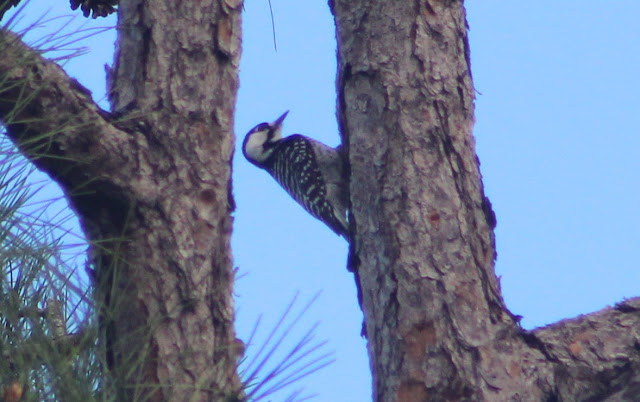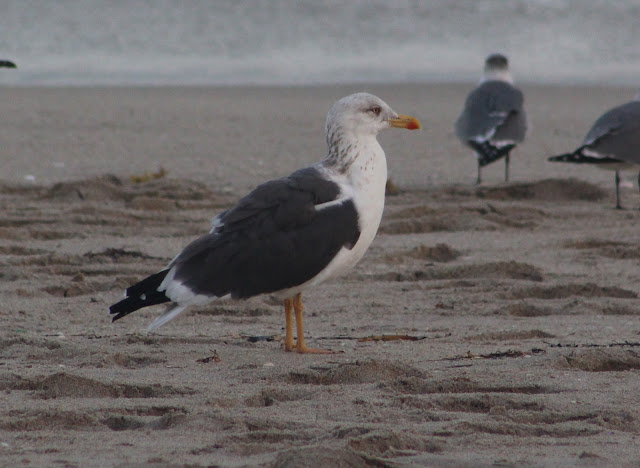This will be the final post for the series, Florida. I've gotta say Florida is freaking awesome and I love the birding there. In similar ways to Arizona and Texas, one has to visit Florida several to many times to see everything. This will go down as a great introduction to Florida. For this last post, it'll cover the last full day Caleb and I had to bird as well as a half day before I went back to the airport.
On January 5th, Caleb and I decided to go back to the direction of Lake Okeechobee. Our plan for the day was a long one that would feature a search through pinewoods for key species of the southeast, another visit to Torry Island to look at Snail Kites again, a check for Shiny Cowbird, a search for Nanday Parakeet, and another visit to the coast south of Port St. Lucie. Wood Storks led off the day.




Our first stop was at DuPuis Management Area, which is by Port Mayaca and not far east of the Lake Okeechobee's eastern shore. It was here that we birded the southeastern pine forests, also known as the pinewoods. This was a fun stop, and we found our two targets that are characteristic birds of the habitat. The first was Bachman's Sparrow in the understory habitat, and the second was the endangered Red-cockaded Woodpecker. It was great to see both of these species, and Caleb and I also saw them in eastern Texas/western Louisiana. Other fun birds in this area included Red-headed Woodpecker and Carolina Wren.
 |
Bachman's Sparrow (above and below)
|
 |
Red-cockaded Woodpecker
|
Up next was more time to enjoy the Snail Kites from the lookout tower at Torry Island. The kites were quite viewable, especially a young bird close to the tower. An adult was seen but stayed more distant. The juvenile also called some, which we were able to get a recording of.
 |
Snail Kites
|
 |
Northern Rough-winged Swallow
|
We then followed up on an area where Sean has had Shiny Cowbirds within a farm. The habitat was great for blackbirds and such, but it lacked any cowbirds at the time of day we were there. Just when I thought the exotic birding was overwith, Caleb realized that Nanday Parakeets could be found in and around Peaceful Waters Sanctuary near and west of West Palm Beach and Lake Worth. While walking around and looking, we heard a few Nanday Parakeets calling. We weren't able to see them, but at least we heard them for another life bird. Peaceful Waters Sanctuary was cool though, it had trails that went through a series of wetlands. There were lots of cool birds, including our second Spot-breasted Oriole of the trip (the best exotic!)
 |
Common Gallinule
|
 |
Caleb with Little Blue Heron
|
 |
Red-shouldered Hawk
|
 |
Mottled Ducks
|
 |
Palm Warbler
|
 |
Mottled Ducks
|
 |
Green Heron
|
 |
Purple Gallinule
|
 |
Little Blue Heron
|
 |
Spot-breasted Oriole
|
January 5th's last birding stop was at Lake Worth Beach Park, where we spent two hours seawatching. It was awesome to sea-bird again, and watch 254 more south-bound Northern Gannets and 12 more Magnificent Frigatebirds. During this watch the Frigatebirds came close quite a few times and were in awesome lighting. My photos aren't the best but the scope views I had were. 210 Lesser Black-backed Gulls were also impressive to see, most of which were heading south later in the day to roost. A single Great Black-backed Gull was on the beach for quite some time but left before we could get close to it. January 5th was one with diversity in our birding stops!
 |
Northern Gannets
|
 |
Magnificent Frigatebirds
|
 |
Laughing Gull
|
 |
Magnificent Frigatebirds
|
 |
Brown Pelican
|
 |
Lesser Black-backed Gulls
|
 |
| Sanderling |
 |
crazy Muscovey with gulls
|
On January 6th, we had a half-day to bird before Caleb dropped me off at the Orlando Airport. The original plan was to bird at this awesome place called Lake Apopka for the morning, but Caleb suggested trying for Purple Sandpiper (a lifer for me) before going to Lake Apopka. I liked the idea and we rolled with it. For me, it would be my 650th life bird if I could land it (all of which have been in United States so far). Caleb reached his 650th for ABA on January 4th with the exotic parrots in Miami.
The place where up to two Purple Sandpipers were being seen at was called Jetty Park, which is along the coast and just north of Cape Canaveral and not far east of Orlando. We had to pay to get in, but a Purple Sandpiper or two was worth it! The birds were seen on the rocks along a jetty as well as rocks along the dock trail going to the jetty. Finding these birds can be difficult because they weave around the rocks a lot. It took about an hour, but Caleb eventually spotted one on the side of the dock, sitting on a rock. We got to watch it up very close for about 5 minutes before it flew to the jetty rocks. For me, it was awesome to get this bird and reach 650 life birds for the United States. Looking back on my 450th life bird, it was a Surfbird on a jetty in California. Purple Sandpipers are plumb Calidris sandpipers who favor rocky shoreline habitats. This species breeds on Arctic tundra and it is hard to reach their habitat on much of their breeding grounds. In the winter these birds are found regularly to the mid-Atlantic states in the United States, and are less numerous but annual further south (such as Florida). Birders can find them on rocky coastlines and jetties where they favor wave washed rocks. Aside from the Purple Sandiper birdwise, a young Northern Gannet close to the jetty path was freaking awesome to see up close. We also had a great highlight by getting to view Sea Turtles from the dock trail along the jetty!
 |
Sea Turtles
|
 |
Purple Sandpiper, my 650th!
|
 |
young Northern Gannet up close
|



After seeing the Purple Sandpiper, we headed out of Jetty Park and made our way to Lake Apopka, which is not far northwest of Orlando. A road goes through the area in a loop, and is called Lake Apopka Wildlife Drive. It is open three days a week for driving, and we realized the drive was closed on the 6th. Fortunately, we could still hike the drive through endless marshes for over 2 miles one way west to the edge of Lake Apopka. This was a great hike to conclude the Florida adventure. We had Alligators present in abundance after seeing much lower numbers than we thought we would see throughout the course of the trip. One giant one crossed the road, awesome to see. This hike summed up Florida's birding in a lot of ways. The wetlands held some incredible species numbers that included: 180 Black-bellied Whistling-Duck, 65 Fulvous Whistling-Duck, 1,200 Ring-necked Duck, 1,100 Common Gallinule, 3,500 American Coot, 55 Anhinga, and many more among 76 different species we detected.
 |
Blue-headed Vireo
|
 |
Eastern Phoebe
|
 |
Prairie Warbler
|
 |
Cooper's Hawk
|
 |
Common Gallinule
|
 |
Great Blue Heron
|
 |
Roseate Spoonbill
|
 |
| Anhinga |
 |
Blue-winged Teal pair
|
 |
Black-crowned Night-Heron
|
 |
| Gator! |
 |
Gray-headed Swamphen
|
 |
Red-shouldered Hawk
|
 |
Fulvous Whistling-Duck
|
 |
| Limpkin |
 |
Black-bellied Whistling-Ducks
|
 |
Little Blue Heron
|
 |
Glossy Ibis
|
 |
Tricolored Heron
|
Concluding, I got 196 species in Florida in the 6.5 days that we had to bird. It is an excellent state to bird in, and I look forward to going back someday. Thanks to Caleb Strand for the trip and for finding many awesome birds and to Sean Fitzgerald for letting me join Caleb and giving me a place to stay at!





















































































